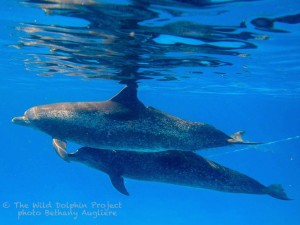
When most people think of dolphins, the first thing that comes to mind is their playful nature, often depicted in movies or documentaries. And to counter that, news articles also like to focus on a darker side of dolphins, sensationalizing their aggressive behavior to grab attention. You know, “dolphins aren’t as friendly as they seem.” But here’s the truth: dolphins are deeply social mammals with complex relationships that last decades—bonding in ways we’re still working to understand.
Denise Herzing, Ph.D., founder and director of the Wild Dolphin Project, is a prominent marine biologist and researcher who has dedicated decades to studying wild dolphins in the Bahamas. Along with her team of colleagues, research assistants, and graduate students, Denise has explored the social dynamics of Atlantic spotted dolphins, including the relationships between mothers and and male alliances.
To study and analyze social structure, researchers use the coefficient of association, a measure used to quantify the degree of association or relationship between individuals in a social group, such as dolphins, within a specific context. In the study of dolphin social structure, the coefficient of association helps researchers understand how frequently or closely certain individuals interact with each other compared to how they interact with others in the group. In simpler terms, it indicates how likely two dolphins are to associate or form bonds based on their interactions over a given period.
The coefficient can range from:
- 0 (no association) – meaning the two dolphins never interact.
- 1 (complete association) – meaning the two dolphins are always seen together.
To calculate it, researchers typically track the frequency and duration of interactions, like physical contact, vocalizations, or proximity in the group. The higher the coefficient of association, the stronger the social bond between the dolphins.
Understanding Dolphin Social Bonds: From Mother-Calf Connections to Male Alliances
In many dolphin populations, including Atlantic spotted dolphins in the Bahamas, bottlenose dolphins in Sarasota Bay, Florida and Monkey Mia Bay in Australia, and orcas in various regions, the strongest bond is typically between a mother and her calf. This connection is crucial for the calf’s survival, as the mother provides not only nourishment but also vital lessons about social behavior, hunting, and navigating the environment. The bond usually remains strong for the first few years of the calf’s life, but it begins to weaken when the mother has a new calf, typically after 3.5 years. This shift occurs as the mother’s attention focuses on the new offspring, and the older calf becomes more independent. However, if the mother does not have another calf, the bond with her first calf often remains strong, with the juvenile continuing to rely on the mother for social learning and protection.

Two moms with their calves. Copyright Wild Dolphin Project.
The next strongest relationship is between adult males, male-male alliances. Stable and long-lasting male-male alliances are observed in several mammal species, including lions, cheetahs, chimpanzees, and of course, various populations of bottlenose dolphins and spotted dolphins. These alliances can help the males survive and reproduce in different ways, such as by reducing the risk of being attacked by predators, offering protection, guarding mates, improving success in fights with rivals, and making hunting more efficient. In bottlenose dolphins, these male partnerships help with things like fighting, herding, and finding food and Denise has seem span decades.

Romeo and BigGash — a male alliance documented for many years by Denise Herzing and the Wild Dolphin Project. Copyright WDP.
The long-term processes behind the formation of social bonds in male dolphins are not fully understood. To explore how these bonds develop, a group of researchers tracked 59 male dolphins over 14 years as they grew from adolescence to adulthood. By examining their genetic relationships and social connections, they found, in a study published in the journal Behavioral Ecology, that most of the bonds formed during adolescence continued into adulthood. While being related influenced associations in adolescence, adult males tended to form bonds with others of similar age. This suggests that peer relationships, rather than family ties, are more important in the development of adult male alliances in dolphins.
References and further reading:
https://academic.oup.com/jmammal/article/103/6/1290/6645508
https://www.wilddolphinproject.org/wp-content/uploads/2011/11/Coeff-of-Assoc-97.pdf
https://pubmed.ncbi.nlm.nih.gov/32210525/
https://www.livescience.com/animals/orcas/grieving-orca-mom-carries-dead-calf-around-on-her-head-for-a-2nd-time

